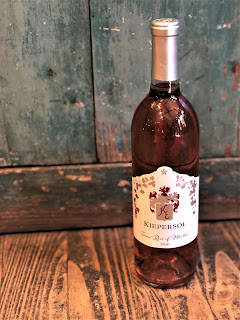By: Connor Brown
When Rosé is mentioned in wine conversations, many of us
think of our grandmothers and the sweet pink wine that we've all snuck tastes
of. However, not all Rosé wine is sweet, and the process of making a rosé wine
is one of the oldest around. It offers a wide range of flavors to appease even
the most picky wine drinkers. While there are many ways to achieve a rosé, one
of the most common methods is called skin contact. This method basically allows
red wine grapes to ferment with the skins for a limited time before the juice
is drained and separated, leaving a wonderful pink juice to continue to mature
into a delectable rosé wine. And though rosés have been produced for centuries,
many US wine regions and other world regions have just started to experiment with
producing dry rosé. Texas, however, has been on the train for quite some time,
and The Grapevine offers a nice selection of them from some of Texas' most
beloved wineries.
Another favorite is the Kiepersol Rosé of Malbec from Tyler,
Texas. This beautiful pale pink wine is light-bodied and mostly dry with wonderful
melon and berry notes, followed by a crisp, smooth, semi-earthy finish. If you
enjoy a Malbec for its soft smooth tannins, and round flavor profile, the
Keipersol Rose of Malbec can easily be your new springtime favorite offering
similar flavors with a lighter and more refreshing taste.
And for those who prefer something on the sweeter side, our
neighbors at Dry Comal Creek here in New Braunfels have been perfecting the
blush for years with their White Black Spanish. This wine has deep Texas roots
with the Lenoir, or Black Spanish, grape that has been imbedded in American
wine growing culture since the 19th century and is now grown vastly in the Lone
Star State. (We even have some growing on the porch at The Grapevine!) This
lovely blend of Black Spanish and French Columbard has a deep garnet color and
tastes of ripe berry and cherry with a soft semi-sweet and jammy finish.
However this wine isn't near too sweet with well-balanced cinnamon and citrus
flavors to keep the sweetness from overpowering the delicate fruit notes that
pull it together.
As someone who almost exclusively drinks Rosé, it's great to
see such prestigious Texas wineries find their viticultural roots in producing
this timeless wine style. It also grants many more options for those red and
white wine drinkers to meet in the middle. In Gruene, we're all about good
times, rich history and fine wine, so let’s all spend less time arguing reds
versus whites and more time enjoying!

